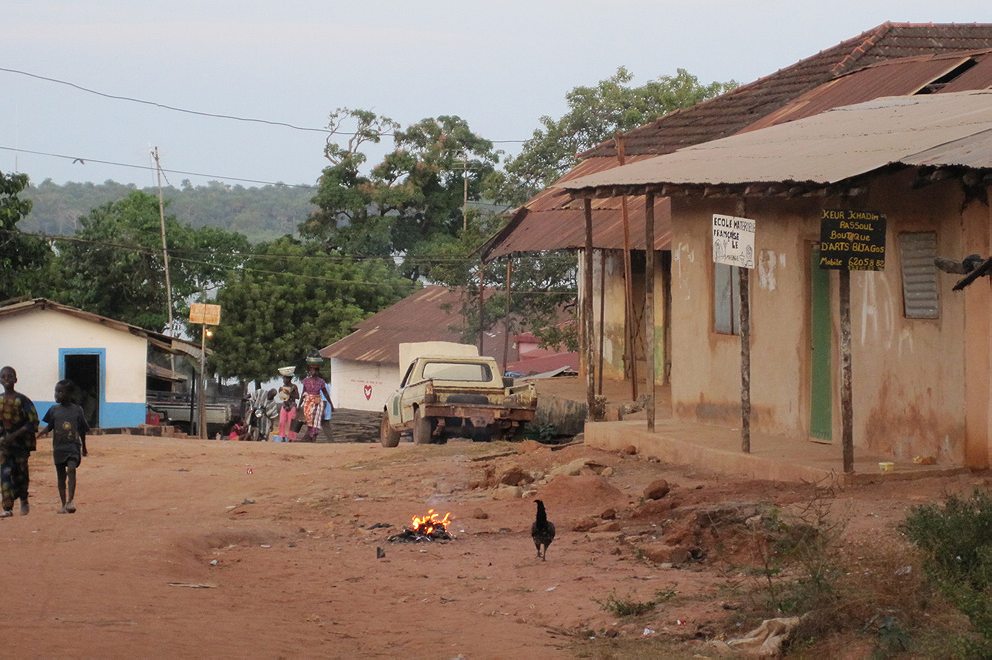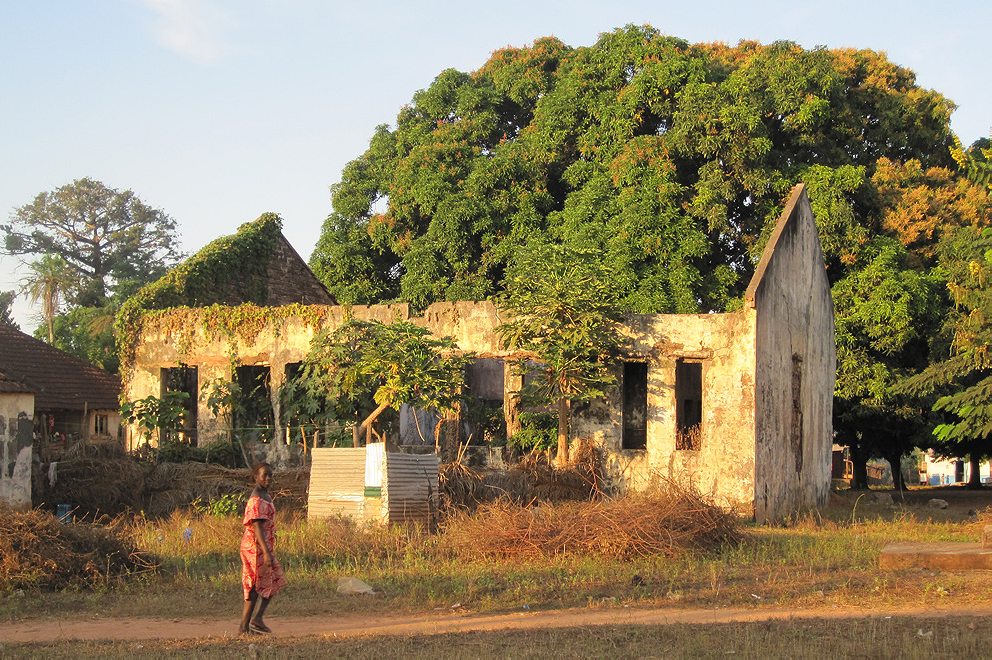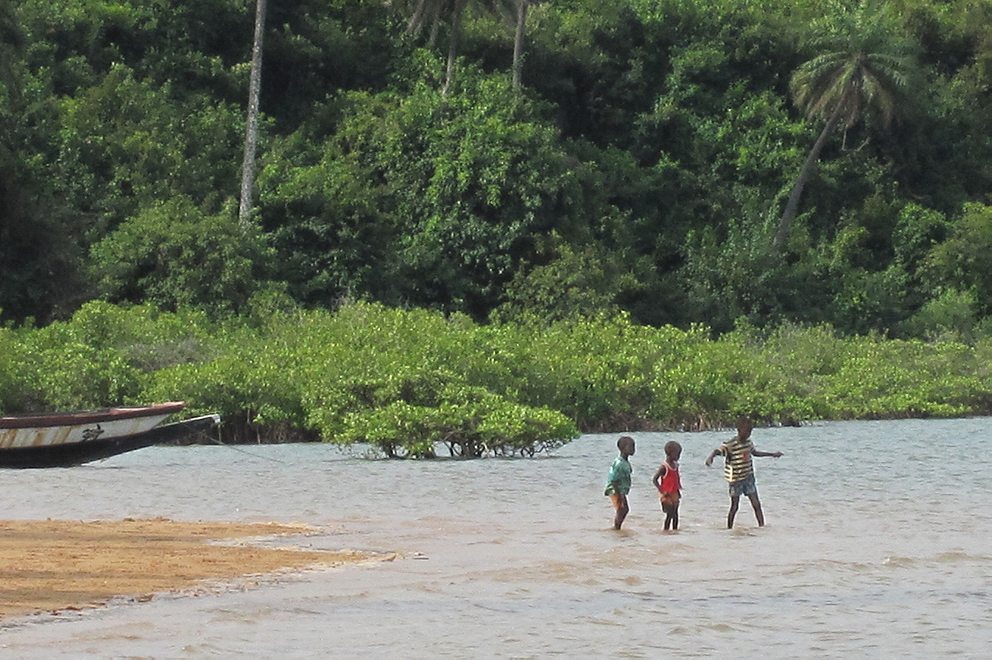A West African archipelago that is home to mangroves and spirit medicine and a story of fertilizing crops with cocaine powder.
This is an excerpt from The Ringtone and the Drum: Travels in the World’s Poorest Countries.
We leave Bissau and take the small passenger ferry to the island of Bubaque in the Bijagós archipelago off the coast of West Africa. It is late December, and although the Bijagó people are predominantly animist, Christmas and New Year are public holidays and the ferry is full of people returning from the mainland for the festivities. It leaves Bissau’s Pidjiguiti harbour two hours late, and the passengers take advantage of the delay to get drunk. Some have brought jerrycans full of palm wine; others buy bottles of beer from the on-board café. On deck a speaker belts out loud West African pop music. Passengers lean on the railings, drinking and chatting merrily. A few dance, clutching beer bottles and waving their arms in the air; the women jerk their backsides provocatively, in time with the music. The sea is flat and calm, the air hot and moist.
The forty-mile journey takes four hours. Two smaller boats, which have hitched a ride to save fuel, bob at the end of ropes in the ferry’s wake. After two hours we pass the first of the archipelago’s eighty or so islands: a muddy strand of beach, a long fringe of palm trees, thick dark forest behind. Only a handful of the islands are inhabited, with a few more settled temporarily during the rice-growing season. This one appears deserted, although from this distance we cannot be certain – many Bijagó villages are hidden deep in the jungle, away from the shore where they would be exposed to flooding and attack. (The Bijagó are notoriously hostile to outsiders. As far back as 445 BC the Phoenician captain Hanno, who sailed down the African coast from Cadiz, was shocked to find the islands inhabited by ‘hairy, swift, monstrous wild women who could not be subdued even with bonds.’ Two thousand years later the first Portuguese explorers met their deaths here. Early slavers, too, encountered fierce resistance and quickly switched their attention to the mainland. And in the colonial wars of pacification, the islanders were the last to be quelled.)
Half an hour later we pass another far-off islet. It is long and low, barely rising above the still sea; in the haze of the late afternoon it shimmers like a mirage. This island too appears empty of humanity, but with the aid of binoculars I make out a small village, thatched roofs resting atop tiny mud houses, nestling among the trees behind the mangroves. A villager, a tiny speck even through the lenses, emerges from the forest, perhaps after a day spent hunting bush rats. A woman is sitting on a stool beside a house, sifting rice. In the foreground a lone sacred ibis scours the beach, its curved black bill burrowing for grubs.

Dusk draws in, and as we pass through a narrow channel between two jungly islands we can feel the archipelago closing in on us, its tropical intensity enveloping the boat in heat, damp and stillness. As we round the far end of the starboard-side island the pungent smell of smoked fish reaches the deck. It is the first sign that we are nearing a human settlement. Ahead of us we see wisps of smoke rising through the palm trees of Bubaque. The ferry carves a wide arc to avoid a submerged sandbar and sweeps round to the right along a channel, with the island and the smoke and the palm trees now close by to our left. A man stands in the darkening sea with a broad fishing net. Behind him two women bend to pluck shellfish from rockpools. On deck the drunken dancers, their numbers now swelled to several dozen, whoop and cheer as we near our destination.
At last the dock comes into view, a high cement platform supported by thick iron pillars. A dense, jostling, hundred-strong crowd is waiting for the ferry, held back from the jetty by a thin rope. They are there to meet relatives returned from the mainland or to trade with the new arrivals or wheelbarrow their belongings to their homes. There are hustlers, ready to grab the few white visitors and lead them to hotels. A fellow passenger warns us that there are probably pickpockets too. It seems the whole island is there. Once again you are forced to relinquish control. We scrum with the others for a place on the narrow gangplank, leaving behind the safety of the well lit deck and plunging into the littoral darkness. We barge through the expectant crowd, pretending we know where we are going. Ignoring the many offers of assistance we choose a rough dirt track to escape the throng, and hope it will lead to a hotel. After fifteen minutes humping our backpacks through a labyrinth of unlit lanes, we stumble with relief on a guesthouse.
The islands are full of mysteries. On our first morning, on the terrace of Bubaque’s only bar, which overlooks the jetty, we meet Michel, a middle-aged Senegalese conservationist with a 1950s crew cut who has come here to teach local people how to fish without depleting stocks to extinction. As we walk in he greets us in French and asks us to sit with him at his small table. He looks tired, his eyes swollen, and is drinking strong black coffee. We exchange pleasantries and establish one another’s business, but we cannot help noticing that his mind is not on the conversation. He keeps shaking his head, as if recovering from a shock, and gazing thoughtfully out over the calm sea. Ebru asks him if he is all right. ‘You see many things here,’ he replies darkly. ‘What kind of things?’ I ask. ‘Inexplicables,’ he whispers.

He has spent the previous night on the island of Canhabaque, an hour’s boat ride southeast of Bubaque. Even by Bijagós standards, Canhabaque is traditional, replete with forest spirits, shrines containing the dead souls of the ancestors, and giant cotton trees harbouring malevolent irān that must be constantly placated with offerings. The island’s inhabitants guard jealously its many sacred sites; despite a long campaign of “pacification” they were never fully subdued by the Portuguese, and were exempted from the hut tax to which the rest of the country was subjected. A close-knit community of rice farmers and bushmeat hunters, whose economy is still based on barter, not cash, Canhabaque is closed off from the modern world, and remains wary of strangers.
Michel was unprepared for its enigmas. Walking down a village lane in the early evening he saw a dead snake on the ground, its body twisted like dried kelp. He was told it had been killed by the amulet, or gris gris, of a passing witch doctor. The witch doctor had been unaware of the snake’s presence, but his gris gris was so powerful that the snake only had to approach and its fate was sealed.
At night Michel was given a hut to sleep in, but he was allowed no rest. ‘I was terrified,’ he says. ‘A village woman spent the whole night running back and forth outside my hut, screaming at the top of her voice. She sounded mad, as if the devil himself was inside her. She didn’t stop until dawn. It wasn’t just the noise that kept me awake – her bloodcurdling screams gave me the shivers. I was cowering inside my hut listening to her padding around just outside the door.’
He finally placated the chief by giving him some francs and was allowed to go on his way.
Michel discovered in the morning that the panicked woman had been conversing with the spirits of the forest, asking them what this interloper was doing in the village and whether his intentions were benign or evil. But his troubles did not end there, for at dawn he was summoned to see the village chief, who welcomed him by ranting angrily at him in Bijagó, a language Michel does not speak. The tirade lasted over an hour. ‘I asked my companion what the chief wanted and whether I was being taken prisoner,’ he says, his fears echoing those of the eighteenth-century explorer Mungo Park, who during his voyage to the Niger was regularly held captive by village chiefs. Park had to buy his freedom with his dwindling store of provisions, but Michel had not come similarly equipped. ‘The chief wanted palm wine or rum in return for his hospitality in putting me up for the night, but I didn’t have anything to give him. I didn’t even take pencils or paper with me in case they would think I was spying for the government. They are afraid of the government because it tries to tax them.’ He finally placated the chief by giving him some francs, which could be used at a later date to buy rum in Bubaque, and was allowed to go on his way. ‘It’s very traditional in these islands,’ he sighs, exhausted and unused to such irruptions in his life, ‘very traditional.’
The following day, Christmas Day, we spend on the beach. A short walk from the dock, down a rough path through low bush, a curve of white sand sheltered by nodding palm trees stretches below a red, jungle-covered cliff. Clumps of mangrove dot the shore. Dolphins frolic in the waveless sea. A few hundred yards across lies another island, deserted. A gaudily painted fishing canoe works the channels between the sandbars as a light breeze disperses the heat from a watery sun. There is no sound.

On hearing that I am writing a book, Michel is keen to tell me about his work as a conservationist. One morning he takes me down to Bubaque’s small market and shows me a stall selling shark fins. The dried, yellowing fins, shaped like breaking waves, are laid out flat on a plastic sheet on the ground. Traditionally, sharks were thought by the Bijagó to have special powers, and they are still represented in local dances and on masks, but Chinese demand for their body parts for use in soup has proved irresistible to the islanders, and the revered fish are now under threat.
The average Guinean would have to work for two months to earn what he can make from selling just one kilo of fins, so when shark dealers come calling from Senegal and Guinea-Conakry it is hard to refuse their business. Once a shark is caught, its fins are sliced off and its body thrown back into the sea, where if not already dead, it bleeds to death or is eaten by other sharks. A number of species have already become extinct in Bijagó waters. Others will die out soon if the fin trade continues. ‘The trade is unbalancing marine ecosystems,’ Michel says. ‘But it’s not just sharks – many fish species are in danger because of overfishing by local people and by foreign boats which plunder our seas.’ (For the past two weeks, he tells me, the Guinean government has been holding in custody a trawlerful of Spanish fishermen who exceeded their quotas.) As well as thinning out the food reserves available to the Bijagó people, the depletion of fish stocks is likely to harm tourism, for the majority of overseas visitors to the islands are European sea anglers in search of tarpon and other large game fish. ‘What will people turn to when the fish run out?’ Michel asks, frowning and turning his palms skyward.
They hastily change the subject—it is far too dangerous to talk.
He already knows the answer to his question, but is unwilling to elucidate. There is one subject that nobody in the Bijagós wants to discuss. It is the islands’ dirty secret. Mention it and even the most garrulous clam up. They look at the floor, inspect their fingernails, and shift uneasily in their seats. Then they hastily change the subject – it is far too dangerous to talk.
The story begins on a hazy afternoon in 2005, when a fisherman on a beach near Quinhamel on the mainland spots a strange object floating in the shallows. On closer inspection he sees that it is a white brick, tightly wrapped in transparent rubber. Intrigued, he wades in to retrieve it. Soon after, he sees another of these bricks, washed up further along the beach. He shows his unusual catch to his fellow fishermen, and together they puzzle over its purpose. They rip open one of the packages, and find that the bricks crumble when rubbed. After some delib- eration they conclude that it must be fertiliser. Dozens of packets of fertiliser are bobbing in the surf! The fish-starved sea has yielded up a rare bounty: respite for struggling farmers, a tonic for the parched soil, the promise – for once – of a rich harvest.

The fishermen gather up the packages and, like warriors bringing back the spoils of victory, convey them to their village. The villagers crowd around, singing and dancing. This year they will eat! Their children will grow strong! Maybe – is it possible? – their infants will all survive the year. They give thanks to the ancestors. Some daub their faces with the white powder. They go out into the fields and scatter the precious crumbs.
Instead of thriving, however, their crops wither and die. A few villagers, moreover, are behaving strangely, as if possessed. Have they been cursed? Has the treacherous ocean tricked them? The villagers’ hope quickly turns to bleak despair; now it will be more difficult than ever to feed their families. They are still despondent several days later, when two mysterious, white- faced strangers appear among the huts. Like the wandering gypsy Melquíades in Macondo, they emerge from the forest bearing gifts. Colombians (like Melquíades), they offer the villagers huge sums of money in exchange for the remaining white bricks and their silence. The packages, it turns out, contained not fertiliser but cocaine, for the Colombians had chosen Guinea-Bissau as a staging post on the cocaine route to Europe. The white bricks came from a ship that had sunk at the end of its ocean crossing, its intended destination the Bijagós archipelago. As in Macondo, nothing in the islands, perhaps nothing in the country, would ever be the same again.